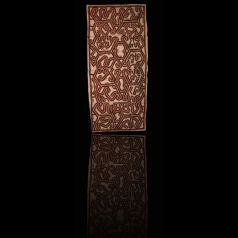
ECORCE BATTUE TAPA
TAPA CLOTH
DESCRIPTIF / DESCRIPTION :
Très beau tapa de grande taille. Le tapa est la première étoffe dont on ait disposé dans cette région du monde. Ses usages étaient variés : vêtements, linceuls, couvertures, moustiquaires, sacs, monnaie de prestige pour certaines pièces de grande qualité. Les tapas de la région de Popondetta sont faits à partir de l'écorce du murier à papier. L'écorce est extraite, humidifiée, battue, sechée. Le fait de la battre tasse les fibres et les soude entre elles. Selon le type de battage, l'épaisseur, la texture et la souplesse de l'étoffe varient. Les motifs dessinés évoquent de manière abstraite et symbolique un certain nombre d'évênements ou de faits importants. Ici, les symboles sont souvent féminins et évoquent en particulier la virginité. Du reste, il faut noter que le tapa est un des rares objets du pacifique conçus et fabriqués de bout en bout uniquement par des femmes. Le tapa présenté ici sert de tunique de danse. En europe, il est à envisager comme une peinture que l'on mettrait au mur. Pigments naturels.
Painted beated bark called Tapa. Tapa cloth is the first material in this region of the world that has been available for people to make clothes, covers, mosquitoe nets, exchange currency etc. Tapa cloth from Popondetta area are made from the bark of the blueberry tree. The intenal bark is extracted, moistened, beaten, and dried. The fact of beating it compresses fibers and soda between them. According to the type of beating, the thickness, the texture and the flexibility of the material vary. The drawn motives evoke in a abstract and symbolic way certain number of important facts. Here, the symbols are often feminine and evoke in particular the virginity. Tapa presented here serves as tunic of dance. In Europe, it is to envisage as a painting that we could put in the wall. Beatted bark and natural pigments.
Painted beated bark called Tapa. Tapa cloth is the first material in this region of the world that has been available for people to make clothes, covers, mosquitoe nets, exchange currency etc. Tapa cloth from Popondetta area are made from the bark of the blueberry tree. The intenal bark is extracted, moistened, beaten, and dried. The fact of beating it compresses fibers and soda between them. According to the type of beating, the thickness, the texture and the flexibility of the material vary. The drawn motives evoke in a abstract and symbolic way certain number of important facts. Here, the symbols are often feminine and evoke in particular the virginity. Tapa presented here serves as tunic of dance. In Europe, it is to envisage as a painting that we could put in the wall. Beatted bark and natural pigments.
- REFERENCE : 538
- DIMENSION / SIZE : Env. 154 x 74 cm
- VILLAGE / VILLAGE : POPONDETTA
- REGION / AREA :GOLFE PAPOU / PAPUAN GULF
- PAYS / COUNTRY : PAPOUASIE NOUVELLE GUINEE / PAPUA NEW GUINEA
